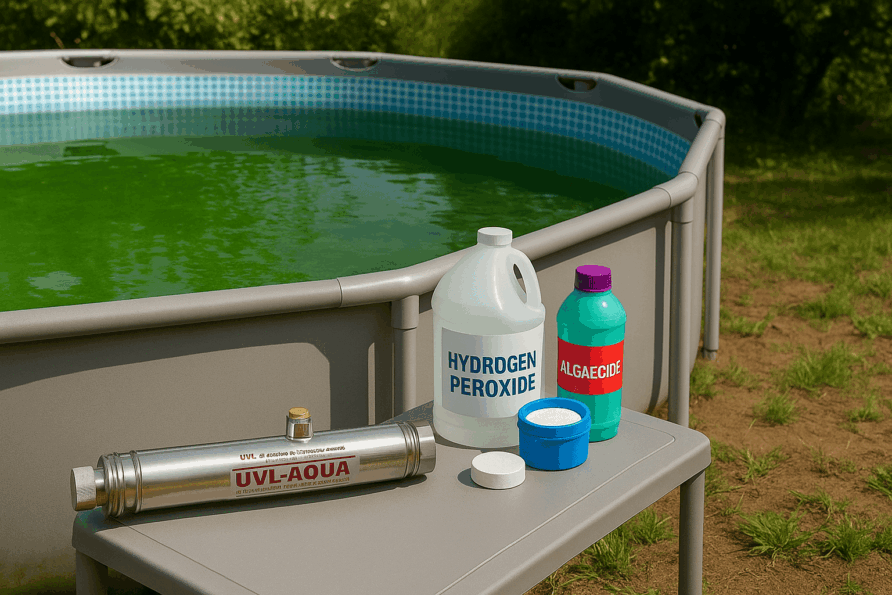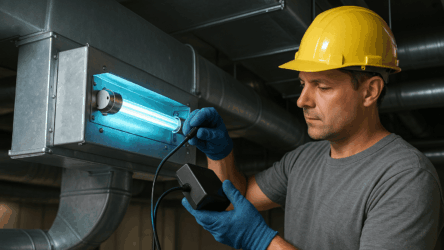Hot weather often brings a common issue for owners of backyard frame pools—green or murky water. It loses its clarity, slippery buildup appears on the pool walls, and swimming becomes unsafe. In this article, we’ll explain why this happens and how to restore your pool to a clean and sparkling state.
Why Pool Water Becomes Green and Cloudy
When regular maintenance is neglected, algae, bacteria, and other microorganisms begin to multiply rapidly. The most common causes include:
- Poor filtration or a clogged filter. Without sufficient water circulation, organic waste like dust, leaves, dead skin, hair, and dirt starts to build up. These impurities create a breeding ground for microbes.
- Lack of consistent chemical treatment. Disinfection agents such as chlorine or hydrogen peroxide must be added regularly to maintain balance.
- Hot sunny weather. High temperatures and intense sunlight accelerate algae growth, leading to "blooming."
What to Do If the Water Is Already Green
If your pool has turned green, follow these steps:
- Apply chlorine (tablets or powder) to reach a free chlorine concentration of 0.3–0.6 mg/L. This eliminates most bacteria and viruses.
- Add an algaecide immediately after chlorination. Algaecides destroy algae cells and halt photosynthesis. Always follow dosing instructions carefully.
- As an alternative or supplement, 37% hydrogen peroxide can be used. It’s effective against most pathogens and doesn’t alter the water’s pH—making it ideal for maintaining chemical balance. However, in severe algae blooms, peroxide alone may not be sufficient.
A pool care specialist advises:
“After treating the water with hydrogen peroxide and algaecide, you’ll see sediment—these are dead algae and organic remains. For complete clarity, it’s essential to vacuum the bottom and walls of the pool using a dedicated water vacuum.”
If the water is heavily contaminated, the best solution might be a full reset:
- Drain all the water
- Scrub the pool walls and floor
- Sanitize the surfaces
- Clean or replace the filtration system
- Refill with fresh water and carry out shock chlorination
How to Prevent Green or Cloudy Water
According to chemical treatment experts, maintaining water clarity and safety requires regular use of disinfection agents that prevent microbial growth. Modern multi-function tablets (3-in-1 or 5-in-1) typically include chlorine, algaecides, coagulants, and stabilizers. Choosing the right formulation and dosage depends on your water quality and pool usage.
In some cases, hydrogen peroxide is sufficient. In others, a filtration system and occasional shock treatment are necessary.
Also essential:
- Clean and maintain your sand or cartridge filters regularly.
- Install a UV sterilizer.
UV disinfection lamps are increasingly used to improve water safety and reduce chemical use. Even basic filtration systems can be enhanced with UV disinfection units. For frame pools from 4 to 20 m³, UVL-AQUA 15 to POOL 40 models are highly effective.
Just ensure your water’s light transmittance is at least 85%, or the required UV dose (25 mJ/cm²) won’t be achieved—reducing disinfection efficiency.
There are other disinfection methods as well. If you want to compare them and choose the right system for your pool, check out our detailed guide on pool water treatment.
Conclusion
If your pool water becomes green or cloudy, don’t panic—it’s a fixable problem. With the right approach and consistent care, you can quickly restore water clarity. And with proper filtration, chemical prevention, and the use of UV disinfection systems, you can avoid these issues in the future and enjoy clean, safe, and crystal-clear water all season long







